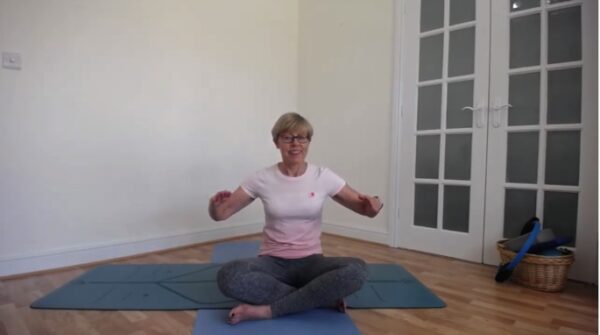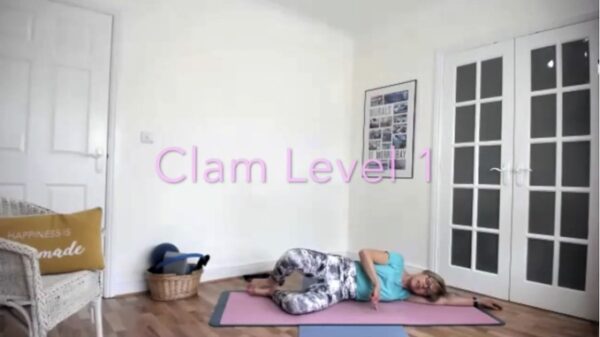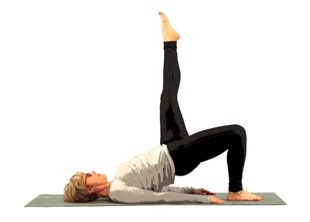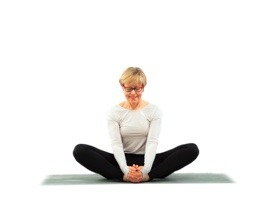MenopauseMenu guest blog post by Phillipa Butler, Chartered Physiotherapist (in England!) and owner of Precizion, Movement and Mindfulness to Maximise Midlife.
Menopause was not on my radar, something inevitable, natural even. I was definitely not expecting it to creep up on me in my mid forties. But I should have been!
The end of the reproductive years is inevitable for a woman, it is a natural part of ageing that usually occurs between 45 and 55 years of age. Menopause is defined as occurring when a year passes without having had a menstrual period. In the UK, the average age for a woman to reach menopause is 51.
Most women will experience some symptoms around the menopause but the age of onset, duration and severity varies greatly from woman to woman. The many structures and systems which can be affected include our bones, muscles, brain, cardiovascular system and the pelvic floor.
Pelvic Floor Dysfunction
I had two big babies “naturally,” if you can call it that! I always say that I got away with number one and that it was number two who did the “damage.” I think you will know what I mean.

Pelvic floor dysfunction (PFD) affects many women and yet remains heavily under-reported. In a 2014 study to ascertain the prevalence of urinary incontinence: 40% of respondents had suffered urinary incontinence. This is a lot of women, so why are we not talking about this more? Well embarrassment is why but also an acceptance that this is an inevitable part of ageing put together with a lack of awareness of the treatment options available.
Symptoms of Pelvic Floor Dysfunction
Pelvic Organ Prolapse
Pelvic organ prolapse is one of the most common gynaecological disorders and the 3rd most common cause of gynaecological surgery especially post menopause.
A prolapse occurs when 1 or more of the organs in the pelvis slip down from their normal position and bulge into the vagina. Having had a baby and having a BMI greater than 30 also add to the risk of suffering a pelvic organ prolapse. Symptoms include:
- feeling of heaviness around your lower tummy and genitals
- a dragging discomfort inside your vagina
- feeling like there is something coming down into your vagina – it may feel like sitting on a small ball
- feeling or seeing a bulge or lump in or coming out of your vagina
- discomfort or numbness during sex
- problems peeing – such as feeling like your bladder is not emptying fully, needing to go to the toilet more often, or stress incontinence.
Urinary Incontinence (UI)
Incontinence is defined as the involuntary leakage of urine from the bladder. Incontinence can affect both men and women in any age group but is more common in women.
The most common types of urinary incontinence in women are:
- Stress incontinence is caused by weak pelvic floor muscles. The most common symptoms are leakage of urine with coughing, laughing, sneezing, or lifting objects.
- Urge incontinence (also called “overactive bladder”) is caused by overly active or irritated bladder muscles. The most common symptom is the frequent and sudden urge to urinate, with occasional leakage of urine.
Problems Associated with the Bowel
Faecal incontinence or accidental leakage of bowel movements affects almost 25 percent of females over 40 years of age. Thus, fecal incontinence is more common than most medical conditions and it has a profound impact on quality of life. Other symptoms include:
- Accidental leakage of wind or flatal incontinence is much more common than fecal incontinence, with almost three times as many females reporting leakage of gas.
- Constipation is common in postmenopausal women. It may occur as a result of declining hormone levels and can be made worse because of weakened pelvic floor muscles.
- Needing to urgently or frequently go to the toilet to pass bowel movements can be associated with pelvic floor dysfunction.
- Rectal heaviness, a bulge or difficulty emptying your bowel can be a sign of bowel prolapse or rectocele. (See Pelvic Organ Prolapse)
Genitourinary Syndrome of Menopause
The decline in sex hormones only serves to compound the situation with the set of symptoms now labelled the genitourinary syndrome of menopause (GSM). This is a hypoestrogenic condition with external genital, urological, and sexual implications. It affects more than 50% of postmenopausal women although only about 25% seek out help.
Genitourinary syndrome of menopause (GSM) signs and symptoms may include:
- Vaginal dryness
- Vaginal burning
- Vaginal discharge
- Genital itching
- Burning with urination
- Urgency with urination
- Recurrent urinary tract infections
- Urinary incontinence
- Light bleeding after intercourse
- Discomfort with intercourse
- Decreased vaginal lubrication during sexual activity
- Shortening and tightening of the vaginal canal
A woman’s symptoms will vary in severity, and it is possible to experience multiple symptoms at once.
Potentially Serious Symptoms
If you experience any of the following symptoms it may be wise to seek out urgent medical attention:
- Pee blockage or pain when peeing
- Blood in urine
- Frequent and intense need to pee
- Burning feeling when peeing
- The inability to empty or control the bladder
- Pressure or pain in the pelvic region
- Unusual or abnormal vaginal bleeding after menopause
- A persistent change in bowel habits sometimes with abdominal pain
- Blood in the stool without symptoms of piles (hemorrhoids)
- Abdominal pain, discomfort or bloating brought on by eating – sometimes resulting in a reduction in the amount of food eaten and weight loss
Exercise and the Pelvic Floor

Some exercise and daily activities can adversely impact a pelvic floor condition by overloading the muscles including
- high impact exercise such as jogging, trampolining;
- exercises that increase intra-abdominal pressure such as weight lifting and strong abdominal exercises;
- exercise that encourages overuse of pelvic floor contractions without sufficient release can actually contribute to problems, and
- weight-bearing exercises with a wide open-legged stance.
Whereas moderate physical activity such as Pilates actually decreases the risk of urinary incontinence.
Pilates and the Pelvic Floor
Pilates takes a special interest in the pelvic floor as a contributor to the deep stabilising function of the muscles of the core. The six foundational principles of Pilates of breathing, centering, concentration, control, flow and precision lend themselves well to a programme of exercise with respects, protects and even has the potential to rehabilitate the pelvic floor. But where do we begin?
Goals for Retraining
- Re-training of breathing patterns.
- Re-education of pelvic floor muscle activation.
- Finally we Integrate pelvic floor muscle activation into Pilates.
Breathing

During inspiration, the diaphragm and external intercostal muscles contract, causing the rib cage to expand and move outward, increasing the thoracic cavity and lung volume. This contraction creates a vacuum, which pulls air into the lungs. Upon exhalation, the diaphragm relaxes and returns to its dome like shape, and air is forced out of the lungs. The relaxation of the diaphragm with exhalation is coordinated with an increased level of activity in the muscles of the pelvic floor.
Breathing is an automatic process so what could possibly go wrong? You would be surprised! Check out this video on YouTube to be sure you’ve got it right:
Posture and alignment; the watchword of Pilates is really important for optimal functioning of the diaphragm and thus the pelvic floor. It is important to position the pelvis in a neutral position and stack the ribcage directly above the pelvis. Next, bring the black of the head in line with the back of your body. Check out these articles to improve your posture with Pilates Part 1 and Part 2.
Pelvic Floor Muscle Training (PFMT)
This is actually harder than you might think and a study in 1991 found that after being given verbal instructions 50% of women couldn’t contract the pelvic floor correctly and that half of these were instead doing things that could promote incontinence in the future.
- The first step in performing pelvic floor muscle exercises is to identify the correct muscles. Women who are familiar with using tampons can imagine squeezing in the vagina as if squeezing a tampon up higher in the vagina or picture the pelvic floor like the centre of a tissue and “pick up” the centre of the tissue. Only this week I heard a cue to “close the elevator doors and travel up two floors.” The most important thing is to find something that works for you.
- When contracting your PFM you should NOT hold your breath, feel your buttocks tighten, legs rotate out, any movement of your spine or pelvis or downward pressure into the perineum. Practice pelvic floor muscle training in a variety of positions and finally incorporate PFMT into movement.
- Try a combination of slow holds for 3-5 seconds, while breathing normally, also brief rapid contractions (lift then immediately let go and relax). Repeat x10 and work towards 3 sets of 10.
Now we integrate the Pelvic Floor contractions into Pilates
There are some close associations between the deep abdominal muscles targeted during Pilates, also the deep hip rotators and the gluteal muscles. A knowledgeable teacher will harness these associations to enhance and incorporate pelvic floor muscle training into regular classes as I do. One particularly synergistic movement is the Clam.

Pilates Clam Level 1 and 2: Lying on the side with the knees bent to about 45 degrees and the heels in line with the back of the body. Position the pelvis and spine in the neutral spine alignment and inhale to prepare and as you exhale float the top knee and simultaneously contract the pelvic floor muscles, in particular the posterior part around the anus. Inhale as you lower and release. Repeat x5.
About Phillipa

I am a Chartered Physiotherapist with a wealth of experience treating musculoskeletal conditions; disorders affecting bones, joints and muscles. I have spent my career developing and refining my knowledge and skills and I am passionate about movement as medicine. I am a certified Pilates Mat and Reformer teacher, 200 hours certified Hatha Yoga instructor and certified meditation teacher.

I offer online Physiotherapy advice, private movement coaching, group Pilates and Yoga classes, workshops and I provide ongoing support to guide you on your journey to optimal health. My philosophy in my own life is that prevention is better than cure and I believe that undertaking a regular programme of appropriate exercise is the key to a fitter, healthier future. I work to help people achieve their goals, to manage pain, improve overall performance and participate in activities they enjoy.

As a woman of a certain age I am all too aware of the effects of the Menopause on our bodies and I have spent some considerable time researching and developing my Pilates for Menopause Programme. Pilates has been shown to improve posture, dynamic balance and the strength of muscle and bone and is the perfect antidote to the challenges of Menopause, ageing and the impact of our modern lives.
Editors note: Although Phillipa lives in England, she is always happy to help and can be reached via her website (with multiple links to her Instagram, Facebook, YouTube, LinkedIn and Podcast social media platforms).